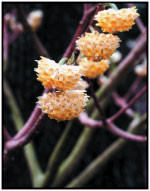Edgeworthia Lends Blooms and Fragrance to Winter
go.ncsu.edu/readext?236001
en Español / em Português
El inglés es el idioma de control de esta página. En la medida en que haya algún conflicto entre la traducción al inglés y la traducción, el inglés prevalece.
Al hacer clic en el enlace de traducción se activa un servicio de traducción gratuito para convertir la página al español. Al igual que con cualquier traducción por Internet, la conversión no es sensible al contexto y puede que no traduzca el texto en su significado original. NC State Extension no garantiza la exactitud del texto traducido. Por favor, tenga en cuenta que algunas aplicaciones y/o servicios pueden no funcionar como se espera cuando se traducen.
Português
Inglês é o idioma de controle desta página. Na medida que haja algum conflito entre o texto original em Inglês e a tradução, o Inglês prevalece.
Ao clicar no link de tradução, um serviço gratuito de tradução será ativado para converter a página para o Português. Como em qualquer tradução pela internet, a conversão não é sensivel ao contexto e pode não ocorrer a tradução para o significado orginal. O serviço de Extensão da Carolina do Norte (NC State Extension) não garante a exatidão do texto traduzido. Por favor, observe que algumas funções ou serviços podem não funcionar como esperado após a tradução.
English
English is the controlling language of this page. To the extent there is any conflict between the English text and the translation, English controls.
Clicking on the translation link activates a free translation service to convert the page to Spanish. As with any Internet translation, the conversion is not context-sensitive and may not translate the text to its original meaning. NC State Extension does not guarantee the accuracy of the translated text. Please note that some applications and/or services may not function as expected when translated.
Collapse ▲
Edgeworthia
chrysantha
Robert E. Lyons
Edgeworthia chrysantha, also known as the paperbush plant, provides superb winter interest and fragrance. This well-branched shrub begins blooming in December, when it’s nothing but a bare silhouette in the garden, and continues through the winter. The individual florets are tiny, but a few dozen make up a 1-1/2 to 2-inch cluster that will simply knock you sideways. Like daphnes, you can smell edgeworthia long before you can see it. The fragrance is a bit like gardenia with a slightly spicier element.
Edgeworthia thrives in partial shade and appreciates well-enriched, moist soil. In spring, after the blooms pass, it sports lovely bluish foliage with silvery undertones that are both eye-catching and soothing. In the summer you might mistake it for rhododendron. It has a beautiful shape and form. Grown in the sun, the foliage is still acceptable, though not as lush green as a rhododendron grown in a shaded area. And in autumn – yes, another season of color – the foliage turns rich shades of yellow.

Edgeworthia chrysantha
Robert E. Lyons
This shrub grows in zones 7 to 9, and in protected areas of Zone 6. It eventually reaches 7 feet high and wide and makes a nice stand-alone specimen or back-of-the-border choice. Space these plants about 7 feet apart in partial shade and rich, moist soil. You don’t have to worry about missing the scent of the blooms, but you may want to plant edgeworthia within reach of passersby because the foliage invites handling. Be sure to snip a few blooms to keep the house fragrant through the winter.
Edgeworthia is now making its way into retail garden centers but may still be a bit hard to find. At the JC Raulston Arboretum, you can view ‘Gold Rush’ in the Winter Garden and ‘John Bryant’ near the Cascade. Another much more scarce cultivar, ‘Red Dragon’, has characteristic orange-red flowers. Although this form isn’t currently in the JCRA display collections, that’s no reason not to visit!
Donald Breedlove


